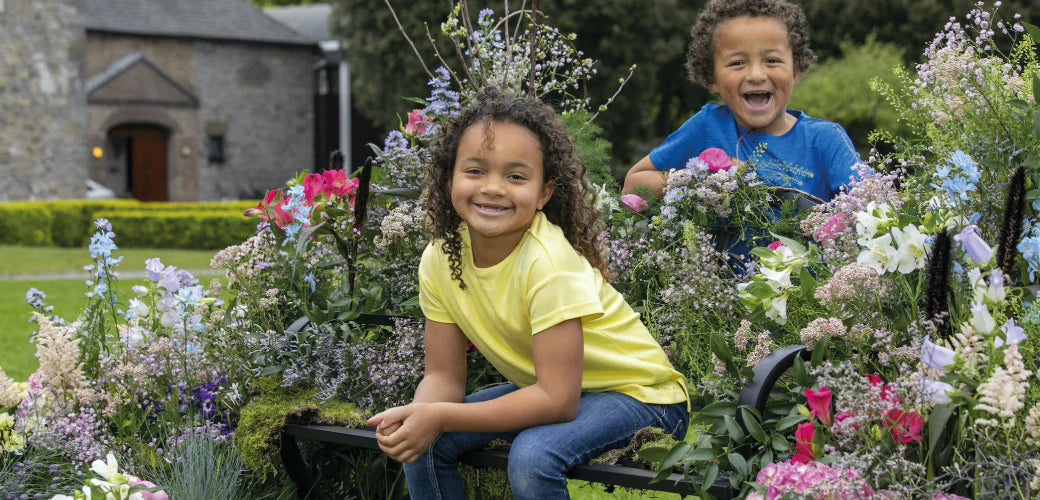The days of artificial-looking, super-manicured gardens filled with alien plant species are over. Instead, the era of a healthy indigenous garden, hosting a biodiverse habitat for local pollinators, has arrived. All in the name of a more sustainable, eco-friendly approach to planting in this century.
So how do we do this? How DO you create a more biodiverse Irish Garden this spring?
There is a lot of good advice on making simple, thoughtful interventions in our properties to cultivate a healthier Irish Garden that supports the environment and local species.
Why Aim For Biodiversity In Your Garden?
Fend off The 6th Mass Extinction
Biodiversity is a goal worth aiming for in the face of what some scientists predict is the 6th Mass Extinction. Unfortunately, this means many indigenous species may be lost to us in the next few years, with possibly dangerous ramifications for our local ecosystems.
Our very own Irish Government has declared a Biodiversity Emergency.
Do It To Save The Pollinators

Take, for example, the loss of crucial pollinators like bees and butterflies. Their absence will have negative consequences for our food supply too. At times like these, EVERY GARDEN is vital to the cause.
Enjoy Nature’s Healing Effect
Nature is good for us, especially those living in urban environments. Exposure to more natural environments is good for your mental health. In addition, it can help stave off allergies in our younger generation by exposing them to more biodiversity at a young age.
A green ribbon, no matter how small in your little urban space, even if it's just a balcony, will also help us stave off the harsher effects of pollution and reduce flooding.
Save Native Flora And Fauna
We must also allow our indigenous species of flora and fauna to thrive by not introducing aggressive new species from outside our island where possible.
What does this look like, and how do we do this? Read on…
What Does Biodiverse In Your Garden Look Like?

It means inviting nature into your garden and backyard or even your balcony.
Create an environment that allows native species in the following categories to thrive:
- Birds
- Bees
- Butterflies and other Pollinators
- Other Insects, such as spiders and earthworms
- Wildflowers,
- Amphibians
- Indigenous flowering trees (where there is space
- Fungi
- Wildlife like squirrels and hedgehogs
A Biodiverse Garden provides a natural environment that gives these species food, shelter, water, stability and security.
So let us look at some steps to foster this environment.
1. Let Go Of That Lawn
Yes! It is time to free yourself from that old ball and chain: that perfectly manicured lawn!
Free yourself from endless fretting about when to mow a lawn. If you have one, try mowing it less often to let wildflowers and dandelions thrive. The bees love this.
What’s more, if you have synthetic grass, it’s time to bring back a more natural surface. It doesn’t always have to be grass. You can use Moss or “Mind Your Own Business”, a plant that crawls naturally over any rocky surface like a lovely green carpet.
Want some tips on rewilding your lawn or even growing a meadow? We have a blog for that. Look at: How To Transform Your Lawn Into A Bee-Friendly Meadow
P.S. Don’t Say No To Weeds

This will take some self-control but think of the bigger picture!
There are some ‘weeds’ that are essential for pollinators, like Bees and dandelions. These early flowering plants in spring provide a ready and urgent supply of post-winter nectar for our pollinators.
Reducing the number of times, you cut your lawn during the spring & summer will help. If you can’t resist mowing, just leave patches in your lawn for weeds, such as dandelions.
2. Make Your Garden A Perfect Birdy Haven Or Pitstop
Remember, all it takes are these clear principles: food, shelter, water, stability and security to support biodiversity.
So think about the ways you can help the native birds in your area find a haven where they can rest, feed and nest.
Are you creating opportunities like sheltering trees or setting up bird boxes and feeding stations?
We have a great blog for that too! Check this out: Love Birds & Birdwatching? Love Your Garden? You’ll Love These Birdcare Ideas!
3. Go Native, When Planting This Spring

Here is a handy list of native flowering plants you can plant in Spring :
- Bluebells (Hyacinthoides non-scripta) - These delicate and fragrant flowers are a favourite of gardeners and are a sure sign that spring has arrived
- Primroses (Primula vulgaris) - These colourful and hardy plants are classic spring flowers and come in various colours, from soft pink to bright yellow
- Daffodils (Narcissus pseudonarcissus) - One of the most recognisable spring flowers, daffodils are easy to grow and provide a burst of cheerful colour to any garden
- Snowdrops (Galanthus nivalis) - These dainty white flowers are one of the first signs of spring and can often be seen peeking through the snow
- Irish moss (Sagina subulata) - This low-growing plant is a famous ground cover and is known for its bright green foliage and tiny white flowers
- Irish heath (Erica cinerea) - This evergreen shrub is a beautiful addition to any garden and produces stunning purple-pink flowers in the spring
- Irish yew (Taxus baccata 'Fastigiata') - This slow-growing evergreen tree is a popular choice for hedges and provides year-round interest in the garden
Don’t forget not all Irish gardens are created equal, some may get more sun and be south facing, or some gardens may be at higher altitudes with cooler temperatures. Coastal Locations may also have specific soil and growing conditions to consider. There may be more particular options suited to your very own microclimate.
4. Plan Your Planting For Year-Round Flowering
You can create a more diverse ecosystem by planting various plants, trees, shrubs, and grasses that will flower and bloom at different times of the year. This ensures a ready supply of nectar for pollinators from the early Spring days throughout the growing season until late Autumn.
This means planning by securing bulbs for later seasons and planting those early in the year.
We even have another blog that will help you later in the year: How To Make Your Garden A Bee-Friendly Habitat This Autumn
5. Build A Stonewall And Create Rockeries

A simple stone wall can do wonders, and what’s more, this is a lovely traditional feature that is part of the Irish vernacular landscape. Why?
Stonewalls are the perfect bug hotel and were built for sheltering wandering seeds. Unfortunately, all those little uneven edges and indentations can play host to both bug shelters and creeping vines.
Solitary bees love those little crevices for building a microhabitat in. Mosses, fungi, lichens and even ferns will.
You can even recreate this in a balcony or small urban yard with a pile of stones in the corner on a raised bed.
Read It to Make It Happen?
There you have it. Some essential advice will help you join the fight to save the native species of flora and fauna of Ireland in your backyard.


